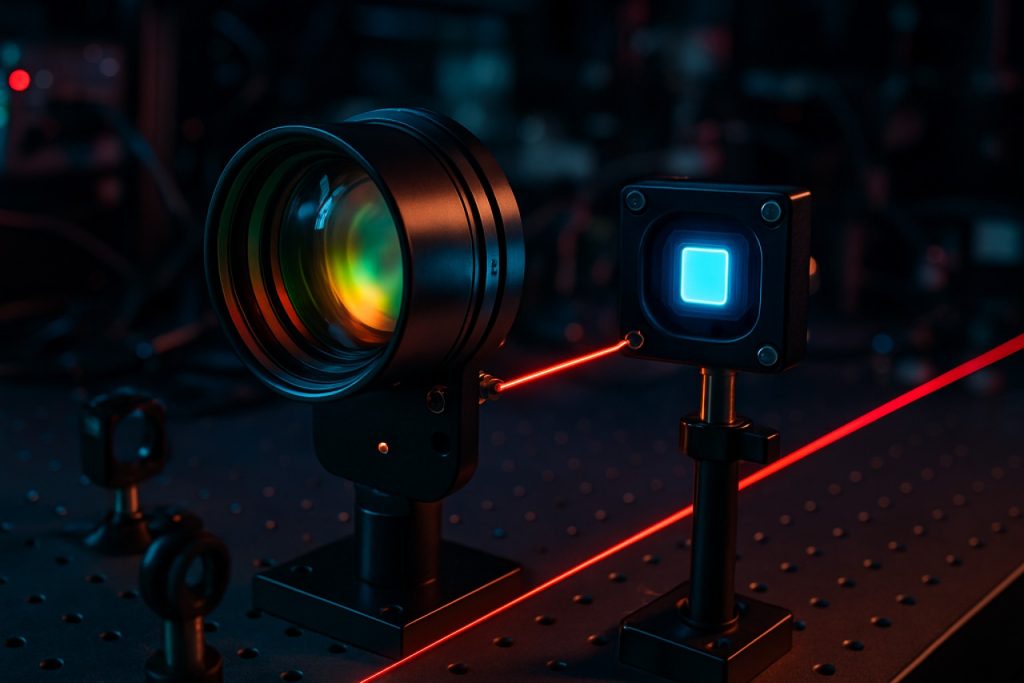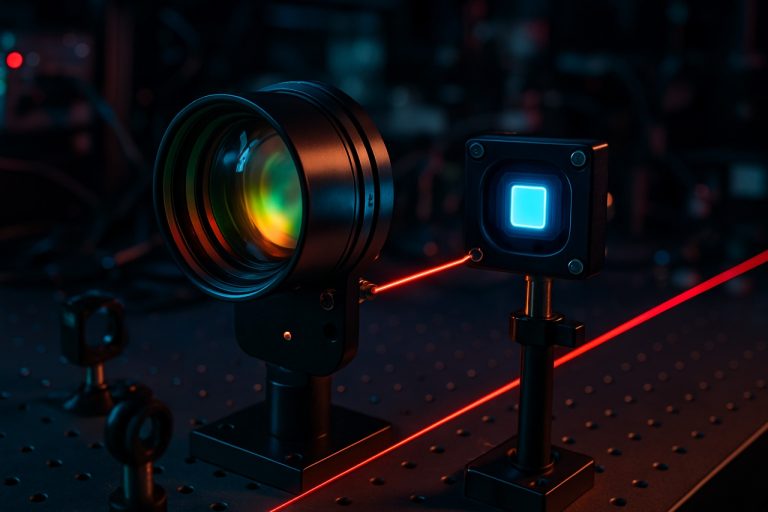
Volumetric Kinematic Optics in 2025: Unleashing the Next Wave of Precision Imaging and Dynamic Sensing. Explore How This Breakthrough Technology Is Shaping Industries and Setting New Standards for the Future.
- Executive Summary: Key Trends and Market Drivers in 2025
- Technology Overview: Principles and Innovations in Volumetric Kinematic Optics
- Current Market Landscape: Leading Players and Industry Structure
- Emerging Applications: From Robotics to Medical Imaging
- Competitive Analysis: Company Strategies and Product Portfolios
- Market Forecast 2025–2029: Growth Projections and Revenue Opportunities
- Regulatory Environment and Industry Standards
- Challenges and Barriers to Adoption
- R&D Pipeline: Breakthroughs and Future Technology Roadmap
- Strategic Outlook: Investment, Partnerships, and Long-Term Opportunities
- Sources & References
Executive Summary: Key Trends and Market Drivers in 2025
Volumetric Kinematic Optics (VKO) is emerging as a transformative technology in the fields of advanced imaging, display systems, and precision metrology. As of 2025, the sector is characterized by rapid innovation, driven by the convergence of photonics, computational imaging, and real-time 3D data processing. VKO systems enable the dynamic manipulation and measurement of light fields in three dimensions, supporting applications ranging from immersive augmented reality (AR) to industrial automation and scientific instrumentation.
A key trend in 2025 is the integration of VKO modules into next-generation AR and mixed reality (MR) headsets. Leading technology companies are investing heavily in volumetric optics to achieve more natural depth perception and spatial interaction. For instance, Microsoft continues to advance its HoloLens platform, leveraging volumetric optical elements for enhanced 3D visualization and user interaction. Similarly, Meta Platforms, Inc. is developing spatial computing devices that rely on kinematic optics for real-time environmental mapping and gesture recognition.
In the industrial sector, VKO is being adopted for high-precision metrology and quality control. Companies such as Carl Zeiss AG and Leica Geosystems AG are incorporating volumetric kinematic optical systems into their measurement solutions, enabling non-contact, high-speed 3D inspection of complex components. This is particularly relevant in semiconductor manufacturing, aerospace, and automotive industries, where tolerances are increasingly stringent.
Another significant driver is the demand for advanced medical imaging. VKO technologies are being explored for real-time volumetric imaging in surgical navigation and diagnostics. Olympus Corporation and Siemens AG are among the companies investigating the integration of kinematic optics into endoscopic and tomographic systems, aiming to improve accuracy and reduce procedure times.
Looking ahead, the outlook for VKO is robust, with ongoing research focused on miniaturization, energy efficiency, and integration with artificial intelligence (AI) for automated analysis. The next few years are expected to see broader commercialization, especially as supply chains for advanced photonic components mature and as standards for interoperability are established by industry bodies such as the Photonics21 platform. As VKO technologies become more accessible, their impact is set to expand across consumer electronics, healthcare, and industrial automation, positioning the field for sustained growth through the late 2020s.
Technology Overview: Principles and Innovations in Volumetric Kinematic Optics
Volumetric Kinematic Optics (VKO) represents a transformative approach in the manipulation and control of light within three-dimensional spaces, leveraging dynamic, spatially reconfigurable optical elements. The core principle of VKO lies in the integration of kinematic mechanisms—such as actuators, micro-electromechanical systems (MEMS), and adaptive materials—into volumetric optical architectures. This enables real-time modulation of optical paths, focal points, and beam shapes, surpassing the limitations of traditional static or planar optics.
Recent advancements in VKO are driven by the convergence of precision engineering, advanced materials, and computational control. In 2025, leading manufacturers are deploying MEMS-based actuators and piezoelectric elements to achieve sub-micron accuracy in the positioning and orientation of optical components within volumetric arrays. For example, Carl Zeiss AG and TRUMPF Group are actively developing adaptive optical systems that utilize kinematic mounts and deformable mirrors for applications in laser material processing and high-resolution imaging. These systems allow for rapid, programmable adjustments to the optical configuration, enabling new capabilities in beam steering, focus control, and aberration correction.
Another significant innovation is the integration of smart materials, such as liquid crystal polymers and electroactive polymers, which can change their optical properties or physical shape in response to electrical stimuli. Companies like Hamamatsu Photonics K.K. are exploring these materials for tunable lenses and dynamic beam shaping devices, which are essential for next-generation volumetric displays and advanced microscopy.
The adoption of VKO is also being accelerated by the development of sophisticated control algorithms and real-time feedback systems. These enable closed-loop operation, where sensor data is used to dynamically adjust the kinematic elements, ensuring optimal optical performance even in changing environmental conditions. Thorlabs, Inc. and Newport Corporation are at the forefront of integrating such control systems into modular optical platforms, making VKO more accessible for research and industrial applications.
Looking ahead, the outlook for VKO is robust, with anticipated breakthroughs in miniaturization, energy efficiency, and integration with photonic circuits. The next few years are expected to see the emergence of fully programmable volumetric optical processors and compact, adaptive imaging systems for medical diagnostics, autonomous vehicles, and augmented reality. As the ecosystem of suppliers and manufacturers expands, VKO is poised to become a foundational technology in both scientific instrumentation and commercial photonics.
Current Market Landscape: Leading Players and Industry Structure
The market for Volumetric Kinematic Optics (VKO) in 2025 is characterized by a dynamic interplay of established photonics manufacturers, emerging deep-tech startups, and cross-sector collaborations. VKO, which enables real-time, three-dimensional manipulation and measurement of light fields, is increasingly central to applications in advanced imaging, autonomous systems, and next-generation display technologies.
Among the leading players, Carl Zeiss AG stands out for its extensive portfolio in precision optics and metrology. Zeiss has leveraged its expertise in optical engineering to develop volumetric imaging modules and adaptive optics systems, targeting both industrial inspection and medical diagnostics. Similarly, Olympus Corporation continues to innovate in volumetric microscopy, integrating kinematic control for enhanced 3D imaging in life sciences and materials research.
In the realm of photonic components, Hamamatsu Photonics is a key supplier of high-speed sensors and spatial light modulators, which are foundational for VKO systems. Their recent advancements in photodetector arrays and MEMS-based optical elements have enabled more compact and responsive volumetric imaging solutions, particularly for machine vision and robotics.
Emerging companies are also shaping the VKO landscape. TRIOPTICS GmbH has introduced precision alignment and calibration systems that facilitate the integration of kinematic optics into complex assemblies, supporting both R&D and high-volume manufacturing. Meanwhile, Edmund Optics provides a broad catalog of off-the-shelf and custom volumetric optical components, catering to rapid prototyping and system integration needs across sectors.
The industry structure is further defined by strategic partnerships between optics manufacturers and technology integrators. For example, collaborations between Leica Microsystems and automation firms are accelerating the deployment of VKO in automated quality control and biomedical imaging. Additionally, the adoption of VKO in automotive LiDAR and AR/VR displays is driving alliances with semiconductor and consumer electronics companies.
Looking ahead, the VKO market is expected to see increased standardization and modularization, as industry bodies and consortia work to establish interoperability protocols. The competitive landscape will likely intensify as more players from adjacent fields—such as MEMS, AI, and quantum photonics—enter the market, seeking to capitalize on the growing demand for volumetric, kinematically controlled optical systems.
Emerging Applications: From Robotics to Medical Imaging
Volumetric kinematic optics—systems that dynamically manipulate light fields in three dimensions—are rapidly transitioning from laboratory prototypes to real-world applications. In 2025, the convergence of advanced materials, microelectromechanical systems (MEMS), and computational imaging is enabling new classes of devices that can actively shape, steer, and focus light in volumetric space. This is catalyzing innovation across robotics, medical imaging, and beyond.
In robotics, volumetric kinematic optics are being integrated into next-generation machine vision systems. These systems leverage tunable lenses, adaptive mirrors, and light field modulators to provide robots with real-time, depth-resolved perception. Companies such as Hamamatsu Photonics and TRIOPTICS are developing precision optical components and assemblies that support dynamic 3D imaging and laser guidance. These technologies are crucial for autonomous navigation, object manipulation, and inspection tasks in industrial and service robotics.
Medical imaging is another sector witnessing rapid adoption. Volumetric kinematic optics are enabling compact, high-speed 3D imaging modalities, such as optical coherence tomography (OCT) and confocal microscopy. Firms like Carl Zeiss AG and Leica Microsystems are incorporating adaptive optics and MEMS-based scanning elements into their imaging platforms, allowing clinicians to visualize tissue structures in unprecedented detail and in real time. These advances are particularly impactful in ophthalmology, dermatology, and minimally invasive surgery, where precise, volumetric visualization is essential.
Emerging applications are also being explored in augmented and virtual reality (AR/VR), where volumetric kinematic optics can generate true 3D images with dynamic focus cues, reducing eye strain and enhancing immersion. Companies such as Holoxica Limited are pioneering holographic and light field display technologies that rely on fast, programmable optical elements to render volumetric content.
Looking ahead, the outlook for volumetric kinematic optics is robust. The ongoing miniaturization of MEMS actuators, advances in computational algorithms, and the integration of photonic materials are expected to drive further performance gains and cost reductions. As these systems become more accessible, their deployment in fields such as autonomous vehicles, remote sensing, and advanced manufacturing is anticipated to accelerate through the late 2020s. Industry leaders and research consortia are actively collaborating to standardize interfaces and protocols, ensuring interoperability and fostering a vibrant ecosystem for volumetric kinematic optical technologies.
Competitive Analysis: Company Strategies and Product Portfolios
The competitive landscape for volumetric kinematic optics in 2025 is characterized by a blend of established photonics leaders and agile startups, each leveraging unique strategies to capture emerging opportunities in advanced imaging, metrology, and display technologies. Volumetric kinematic optics—encompassing dynamic, three-dimensional optical systems with precise motion control—are increasingly central to applications in autonomous vehicles, medical imaging, industrial inspection, and next-generation augmented/virtual reality (AR/VR) platforms.
Among the global leaders, Carl Zeiss AG continues to expand its portfolio of high-precision optical assemblies, integrating kinematic mounts and adaptive optics for both industrial and medical sectors. Zeiss’s strategy emphasizes modularity and system integration, enabling rapid customization for OEMs and research institutions. Their recent investments in automated alignment and calibration technologies further enhance the performance and scalability of volumetric optical systems.
TRIOPTICS GmbH, a subsidiary of Jenoptik, is another key player, focusing on metrology and alignment solutions for complex optical assemblies. Their product lines, such as the OptiCentric and ImageMaster series, are increasingly incorporating kinematic adjustment modules and volumetric measurement capabilities, targeting both R&D and high-throughput manufacturing environments. TRIOPTICS’s close collaboration with semiconductor and AR/VR device manufacturers positions it well for growth as demand for volumetric optics accelerates.
In the United States, Thorlabs, Inc. and Edmund Optics Inc. are expanding their catalogues of kinematic mounts, motorized stages, and adaptive optical components. Thorlabs, in particular, is investing in rapid prototyping and modular system design, allowing customers to assemble and iterate volumetric optical setups with minimal lead times. Edmund Optics is focusing on supplying high-precision, off-the-shelf components for integration into custom volumetric systems, catering to both academic and industrial clients.
Emerging companies are also shaping the competitive dynamics. Optotune AG is notable for its tunable lenses and dynamic optical elements, which are increasingly being integrated into volumetric imaging and scanning systems. Their products enable real-time focal adjustment and 3D imaging, supporting applications in machine vision and medical diagnostics.
Looking ahead, the sector is expected to see intensified competition around system miniaturization, automation, and AI-driven calibration. Companies are investing in R&D to develop more compact, robust, and intelligent volumetric kinematic optics, aiming to meet the stringent requirements of mobile devices, robotics, and wearable displays. Strategic partnerships between optics manufacturers and end-user industries—such as automotive, healthcare, and consumer electronics—are likely to accelerate product innovation and market adoption through 2025 and beyond.
Market Forecast 2025–2029: Growth Projections and Revenue Opportunities
The market for Volumetric Kinematic Optics (VKO) is poised for significant growth between 2025 and 2029, driven by rapid advancements in spatial light modulation, 3D imaging, and adaptive optics. VKO technologies, which enable dynamic control of light in three dimensions, are increasingly being adopted in sectors such as advanced manufacturing, medical imaging, autonomous vehicles, and immersive display systems. The convergence of photonics, precision mechanics, and real-time computational control is expected to unlock new revenue streams and application domains.
Key industry players are investing heavily in R&D to enhance the resolution, speed, and scalability of VKO systems. Hamamatsu Photonics, a global leader in photonics, continues to expand its portfolio of spatial light modulators and adaptive optics components, targeting both industrial and scientific markets. Similarly, TRIOPTICS is advancing precision alignment and metrology solutions that are critical for the assembly and calibration of VKO devices. In the United States, Thorlabs and Edmund Optics are scaling up their offerings in dynamic optical elements and kinematic mounts, supporting the integration of VKO into next-generation imaging and sensing platforms.
The medical sector is anticipated to be a major revenue driver, with VKO enabling breakthroughs in volumetric imaging for diagnostics and minimally invasive procedures. Companies such as Carl Zeiss AG are leveraging their expertise in optics and imaging to develop advanced surgical visualization systems that utilize real-time volumetric data. In parallel, the automotive industry is exploring VKO for high-resolution LiDAR and adaptive headlight systems, with firms like OSRAM investing in photonic modules that incorporate kinematic control for enhanced safety and performance.
From 2025 onward, the VKO market is expected to experience a compound annual growth rate (CAGR) in the high single digits, with total market revenues projected to surpass several billion USD by 2029. Growth will be fueled by increasing demand for high-precision, real-time 3D optical control in both established and emerging applications. Strategic partnerships between optics manufacturers, semiconductor companies, and system integrators are likely to accelerate commercialization and drive down costs, making VKO technologies more accessible across industries.
Looking ahead, the outlook for VKO is robust, with ongoing innovation in materials, micro-electromechanical systems (MEMS), and computational optics expected to further expand the market. As standardization efforts mature and supply chains stabilize, VKO is set to become a foundational technology in the broader photonics and imaging ecosystem.
Regulatory Environment and Industry Standards
The regulatory environment and industry standards for Volumetric Kinematic Optics (VKO) are rapidly evolving as the technology matures and finds applications in sectors such as autonomous vehicles, robotics, medical imaging, and advanced manufacturing. As of 2025, the primary focus is on ensuring interoperability, safety, and performance consistency across diverse VKO systems, which often integrate complex optical, mechanical, and computational components.
Internationally, standardization efforts are being led by organizations such as the International Organization for Standardization (ISO) and the International Electrotechnical Commission (IEC). These bodies are working on frameworks that address the unique calibration, measurement, and safety requirements of volumetric and kinematic optical systems. For example, ISO’s technical committees on optics and photonics (TC 172) and on robotics (TC 299) are collaborating to define protocols for the validation and verification of VKO devices, particularly in safety-critical environments like healthcare and autonomous navigation.
In the United States, the National Institute of Standards and Technology (NIST) is actively developing reference materials and test methods for volumetric optical metrology, with a focus on traceability and reproducibility. NIST’s work is particularly influential in sectors such as precision manufacturing and medical imaging, where VKO systems are used for high-accuracy 3D measurements and diagnostics. The agency is also engaging with industry consortia to harmonize standards with international counterparts, aiming to facilitate global market access for U.S.-developed VKO technologies.
On the industry side, leading manufacturers such as Carl Zeiss AG and Leica Microsystems are participating in standards development, contributing expertise in high-precision optics and metrology. These companies are also implementing internal quality assurance protocols that often exceed current regulatory requirements, anticipating stricter standards as VKO adoption grows. Additionally, industry alliances like the SEMI association are facilitating pre-competitive collaboration on interoperability and data exchange standards, which are critical for integrating VKO systems into larger automation and inspection workflows.
Looking ahead, regulatory bodies are expected to introduce more comprehensive guidelines addressing data security, privacy, and ethical considerations, especially as VKO systems become more prevalent in public and medical domains. The next few years will likely see the publication of new ISO and IEC standards specific to volumetric kinematic measurements, as well as increased regulatory scrutiny of system validation and real-world performance. Industry stakeholders are advised to stay engaged with standards organizations and proactively align their development processes with emerging requirements to ensure compliance and market competitiveness.
Challenges and Barriers to Adoption
Volumetric Kinematic Optics (VKO) represents a transformative approach to light manipulation, enabling dynamic, three-dimensional control of optical fields for applications in imaging, display, and sensing. However, as the field moves into 2025 and beyond, several significant challenges and barriers to widespread adoption remain.
One of the primary technical hurdles is the complexity of fabricating volumetric optical elements with the required precision and scalability. Current manufacturing techniques, such as advanced 3D microfabrication and multi-material additive processes, are still maturing. Companies like Nanoscribe GmbH are at the forefront of high-resolution 3D printing for micro-optics, but scaling these methods for mass production while maintaining optical quality and alignment remains a challenge. The integration of VKO components into existing optical systems also demands new standards for mechanical stability and environmental robustness, as even minor misalignments can degrade performance.
Material limitations further constrain VKO adoption. The need for optically transparent, durable, and tunable materials that can withstand repeated kinematic adjustments is acute. While research into advanced polymers and hybrid materials is ongoing, suppliers such as Dow and Corning Incorporated are only beginning to address the specific requirements for volumetric, reconfigurable optics. The lack of standardized material platforms slows down both prototyping and commercialization.
Another barrier is the integration of actuation and control systems. VKO often relies on precise, multi-axis movement, which requires compact, reliable actuators and real-time feedback mechanisms. Companies like Physik Instrumente (PI) and Thorlabs, Inc. provide piezoelectric and motorized stages, but adapting these for volumetric, in-situ optical manipulation at scale is nontrivial. The need for custom electronics and software further complicates system integration, increasing costs and development time.
Cost remains a significant barrier, especially for applications outside of high-end research and defense. The bespoke nature of current VKO solutions, combined with the lack of economies of scale, results in high per-unit costs. Until manufacturing processes mature and demand increases, VKO is likely to remain confined to niche markets.
Looking ahead, overcoming these challenges will require coordinated efforts between material suppliers, component manufacturers, and system integrators. Industry consortia and standards bodies, such as the Optica (formerly OSA), are expected to play a key role in establishing interoperability standards and best practices. As fabrication, materials, and actuation technologies advance, the barriers to VKO adoption are expected to diminish, opening the door to broader commercial and industrial applications in the latter half of the decade.
R&D Pipeline: Breakthroughs and Future Technology Roadmap
Volumetric kinematic optics—a field at the intersection of adaptive optics, dynamic light modulation, and three-dimensional spatial control—has seen a surge in R&D activity as of 2025. This technology leverages tunable optical elements, often based on microelectromechanical systems (MEMS), liquid crystal arrays, or novel metamaterials, to manipulate light fields in real time across three dimensions. The goal is to enable applications ranging from advanced imaging and display systems to next-generation lidar and optical communication.
In the current R&D pipeline, several industry leaders and research consortia are pushing the boundaries of volumetric kinematic optics. Hamamatsu Photonics, a global leader in photonics and optical components, has been developing MEMS-based spatial light modulators capable of high-speed, high-resolution phase and amplitude control. Their recent prototypes demonstrate sub-millisecond response times and scalable array architectures, which are critical for real-time volumetric imaging and holography.
Another key player, TRIOPTICS, is focusing on precision optical alignment and metrology systems that support the fabrication and calibration of complex kinematic optical assemblies. Their advancements in automated alignment tools are expected to accelerate the commercialization of volumetric optics by reducing production bottlenecks and improving yield.
On the materials front, Corning Incorporated is investing in specialty glass and advanced substrates tailored for tunable and reconfigurable optics. Their work on ultra-flat, low-expansion glass is enabling the next generation of deformable mirrors and adaptive lenses, which are essential for volumetric kinematic systems.
Collaborative research initiatives, such as those led by Optica (formerly OSA), are fostering cross-disciplinary innovation. These consortia are bringing together academic groups, startups, and established manufacturers to address challenges in device miniaturization, power efficiency, and integration with existing photonic platforms.
Looking ahead to the next few years, the technology roadmap for volumetric kinematic optics is expected to focus on three main areas: (1) scaling up device arrays for larger field-of-view and higher resolution; (2) integrating AI-driven control algorithms for adaptive, context-aware optical modulation; and (3) developing robust packaging and environmental protection for deployment in automotive, aerospace, and medical sectors. Early-stage field trials in automotive lidar and augmented reality displays are anticipated by 2026, with broader adoption likely as manufacturing processes mature and costs decrease.
Strategic Outlook: Investment, Partnerships, and Long-Term Opportunities
The strategic outlook for volumetric kinematic optics in 2025 and the coming years is shaped by a convergence of technological advancements, increased investment, and a growing ecosystem of partnerships. Volumetric kinematic optics—encompassing dynamic, three-dimensional optical systems for applications such as advanced imaging, display, and sensing—are attracting significant attention from both established industry leaders and innovative startups.
Major players in optics and photonics, such as Carl Zeiss AG and Leica Camera AG, are actively investing in research and development to expand their portfolios into volumetric and adaptive optical systems. These companies are leveraging their expertise in precision optics and mechatronics to develop next-generation solutions for medical imaging, industrial metrology, and scientific instrumentation. For example, Zeiss has announced increased R&D spending for 2025, with a focus on integrating kinematic control into volumetric imaging platforms, aiming to enhance both resolution and real-time adaptability.
In parallel, technology giants such as Microsoft Corporation and Sony Group Corporation are exploring volumetric kinematic optics for applications in augmented reality (AR), virtual reality (VR), and advanced sensor systems. Microsoft’s ongoing work in volumetric capture and display technologies, particularly for its mixed reality initiatives, is expected to drive further investment and cross-industry collaborations. Sony, with its strong background in imaging sensors and display technologies, is also positioned to capitalize on the integration of kinematic optics into consumer and professional devices.
Strategic partnerships are emerging as a key driver of innovation. Collaborations between optics manufacturers, semiconductor companies, and software developers are accelerating the commercialization of volumetric kinematic systems. For instance, partnerships between TRIOPTICS GmbH—a leader in optical metrology—and automation specialists are enabling the development of high-precision, automated alignment systems for volumetric optics assembly.
Looking ahead, long-term opportunities are expected in sectors such as autonomous vehicles, robotics, and biomedical imaging, where volumetric kinematic optics can provide enhanced depth perception, adaptive focus, and real-time 3D visualization. The increasing demand for miniaturized, high-performance optical systems is likely to spur further investment from both public and private sectors. As the technology matures, standardization efforts led by industry bodies such as the SPIE and Optica will play a crucial role in ensuring interoperability and accelerating market adoption.
In summary, the strategic landscape for volumetric kinematic optics in 2025 is characterized by robust investment, expanding partnerships, and a clear trajectory toward integration in high-growth markets. Companies with strong optical engineering capabilities and a willingness to collaborate across disciplines are best positioned to capture long-term value as the field evolves.
Sources & References
- Microsoft
- Meta Platforms, Inc.
- Carl Zeiss AG
- Olympus Corporation
- Siemens AG
- Photonics21
- Carl Zeiss AG
- Hamamatsu Photonics K.K.
- Thorlabs, Inc.
- Hamamatsu Photonics
- TRIOPTICS GmbH
- Leica Microsystems
- Thorlabs, Inc.
- OSRAM
- International Organization for Standardization
- National Institute of Standards and Technology
- Nanoscribe GmbH
- Physik Instrumente (PI)
- Optica (formerly OSA)
- SPIE



